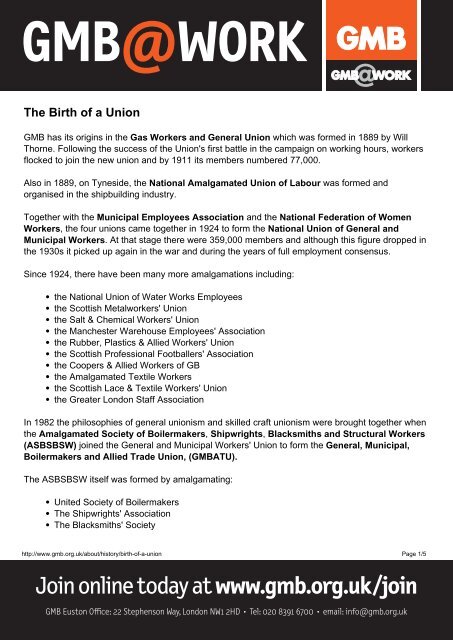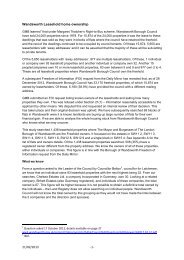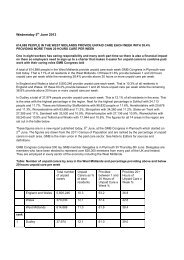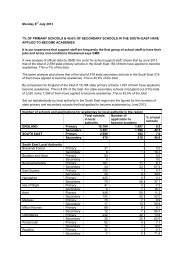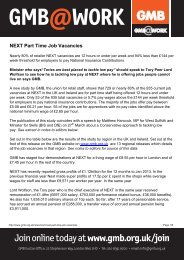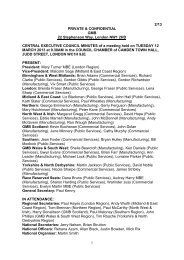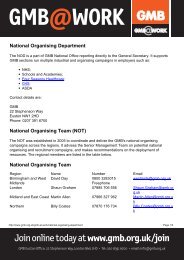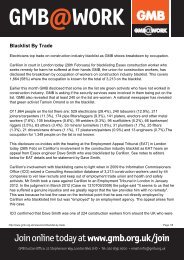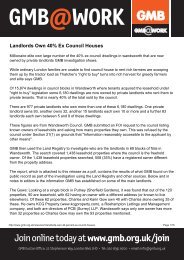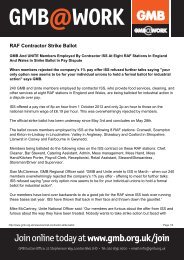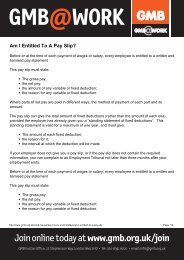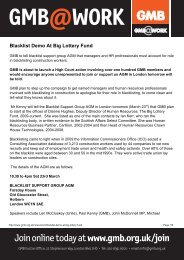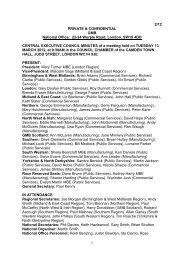The Birth of a Union - GMB
The Birth of a Union - GMB
The Birth of a Union - GMB
You also want an ePaper? Increase the reach of your titles
YUMPU automatically turns print PDFs into web optimized ePapers that Google loves.
<strong>GMB</strong>@WORK<br />
<strong>The</strong> <strong>Birth</strong> <strong>of</strong> a <strong>Union</strong><br />
<strong>GMB</strong> has its origins in the Gas Workers and General <strong>Union</strong> which was formed in 1889 by Will<br />
Thorne. Following the success <strong>of</strong> the <strong>Union</strong>'s first battle in the campaign on working hours, workers<br />
flocked to join the new union and by 1911 its members numbered 77,000.<br />
Also in 1889, on Tyneside, the National Amalgamated <strong>Union</strong> <strong>of</strong> Labour was formed and<br />
organised in the shipbuilding industry.<br />
Together with the Municipal Employees Association and the National Federation <strong>of</strong> Women<br />
Workers, the four unions came together in 1924 to form the National <strong>Union</strong> <strong>of</strong> General and<br />
Municipal Workers. At that stage there were 359,000 members and although this figure dropped in<br />
the 1930s it picked up again in the war and during the years <strong>of</strong> full employment consensus.<br />
Since 1924, there have been many more amalgamations including:<br />
the National <strong>Union</strong> <strong>of</strong> Water Works Employees<br />
the Scottish Metalworkers' <strong>Union</strong><br />
the Salt & Chemical Workers' <strong>Union</strong><br />
the Manchester Warehouse Employees' Association<br />
the Rubber, Plastics & Allied Workers' <strong>Union</strong><br />
the Scottish Pr<strong>of</strong>essional Footballers' Association<br />
the Coopers & Allied Workers <strong>of</strong> GB<br />
the Amalgamated Textile Workers<br />
the Scottish Lace & Textile Workers' <strong>Union</strong><br />
the Greater London Staff Association<br />
In 1982 the philosophies <strong>of</strong> general unionism and skilled craft unionism were brought together when<br />
the Amalgamated Society <strong>of</strong> Boilermakers, Shipwrights, Blacksmiths and Structural Workers<br />
(ASBSBSW) joined the General and Municipal Workers' <strong>Union</strong> to form the General, Municipal,<br />
Boilermakers and Allied Trade <strong>Union</strong>, (<strong>GMB</strong>ATU).<br />
<strong>The</strong> ASBSBSW itself was formed by amalgamating:<br />
United Society <strong>of</strong> Boilermakers<br />
<strong>The</strong> Shipwrights' Association<br />
<strong>The</strong> Blacksmiths' Society<br />
http://www.gmb.org.uk/about/history/birth-<strong>of</strong>-a-union Page 1/5<br />
Join online today at www.gmb.org.uk/join<br />
<strong>GMB</strong> Euston Office: 22 Stephenson Way, London NW1 2HD • Tel: 020 8391 6700 • email: info@gmb.org.uk
<strong>GMB</strong>@WORK<br />
APEX the Association <strong>of</strong> Pr<strong>of</strong>essional, Executive, Clerical and Computer Staff was founded in 1890<br />
when about a dozen men met in an <strong>of</strong>fice in the Strand and decided to form the Clerk's <strong>Union</strong>. As<br />
membership increased and spread across the country, the name was changed to <strong>The</strong> National<br />
<strong>Union</strong> <strong>of</strong> Clerks. In 1920, after rapid growth and the absorption <strong>of</strong> a number <strong>of</strong> other unions, the<br />
membership figure was around 40,000 and the name was again changed to <strong>The</strong> National <strong>Union</strong> <strong>of</strong><br />
Clerks and Administrative Workers (NUCAW).<br />
In 1940, the Association <strong>of</strong> Women Clerks and Secretaries transferred to NUCAW and a new title<br />
was agreed: <strong>The</strong> Clerical and Administrative Workers <strong>Union</strong>. <strong>The</strong>n, in 1972, arising from the<br />
spread <strong>of</strong> the union's influence, changes in <strong>of</strong>fice skills and the growing ability <strong>of</strong> the union to<br />
represent staff at all levels, it changed its title to the Association <strong>of</strong> Pr<strong>of</strong>essional, Executive,<br />
Clerical and Computer Staff (APEX) and they joined <strong>GMB</strong> in 1989.<br />
APEX accepted the Transfer <strong>of</strong> Engagements <strong>of</strong> the Automobile Association Staff and the General<br />
Accident Staff. Since the amalgamation, the Greater London Staff Association, who earlier<br />
transferred to <strong>GMB</strong>, joined the APEX Partnership and the National <strong>Union</strong> <strong>of</strong> Labour Organisers<br />
and Legal Aid Staff Association also transferred to APEX.<br />
NUTGW the National <strong>Union</strong> <strong>of</strong> Tailors & Garment Workers joined the <strong>GMB</strong> in 1991.It is known<br />
that a union existed amongst London tailors as long ago as 1417 but records only date back to the<br />
19th Century.<br />
At the time <strong>of</strong> the merger in 1991, the NUTGW had over 70,000 members and was itself the result <strong>of</strong><br />
many amalgamations including:<br />
Amalgamated Society <strong>of</strong> Journeymen Tailors<br />
Amalgamated <strong>Union</strong> <strong>of</strong> Clothiers' Operatives<br />
Amalgamated Jewish Tailors, Pressers and Machinists' Trade <strong>Union</strong><br />
London Clothiers Cutters<br />
<strong>The</strong> Shirt, Jacket and Overall Workers<br />
<strong>The</strong> Belfast Shirt and Collar Workers<br />
<strong>The</strong>se unions formed the United Garment Workers' <strong>Union</strong> in 1912. <strong>The</strong>y were joined by:<br />
Scottish National Association <strong>of</strong> Operative Tailors<br />
London Operative Tailors<br />
Amalgamated Society <strong>of</strong> Tailors and Tailoresses<br />
http://www.gmb.org.uk/about/history/birth-<strong>of</strong>-a-union Page 2/5<br />
Join online today at www.gmb.org.uk/join<br />
<strong>GMB</strong> Euston Office: 22 Stephenson Way, London NW1 2HD • Tel: 020 8391 6700 • email: info@gmb.org.uk
<strong>GMB</strong>@WORK<br />
In 1931 the unions formed the National <strong>Union</strong> <strong>of</strong> Tailors and Garment Workers and were joined<br />
by the United Ladies Tailors (London) and Waterpro<strong>of</strong> Garment Workers' <strong>Union</strong>.<br />
FTAT the Furniture, Timber, and Allied Trades <strong>Union</strong> merged with the <strong>GMB</strong> in 1993. FTAT can<br />
trace its origin back to 1747 and the formation <strong>of</strong> the National Society <strong>of</strong> Brushmakers and General<br />
Workers. <strong>The</strong> <strong>Union</strong> can therefore lay claim to being the oldest in the world.<br />
At the end <strong>of</strong> the 19th century, three major unions existed in the furniture and upholstery trades: the<br />
Alliance Cabinet Makers, the United Operative Cabinet and Chairmakers' Society <strong>of</strong> Scotland and<br />
the Amalgamated <strong>Union</strong> <strong>of</strong> Upholsterers (AUU). A series <strong>of</strong> mergers culminated in the formation <strong>of</strong><br />
the National <strong>Union</strong> <strong>of</strong> Furniture Trade Operatives (NUFTO) in 1947.<br />
In 1971 NUFTO merged with the Amalgamated Society <strong>of</strong> Woodcutting Machinists to form<br />
FTAT.<br />
<strong>The</strong> latest union to join the fold is the Managerial and Pr<strong>of</strong>essional Officers a Local Government<br />
union comprising 8,000 principal <strong>of</strong>ficers and second tier <strong>of</strong>ficers. Altogether over 100 smaller<br />
unions have joined together to form the modern <strong>GMB</strong> - Britain's General <strong>Union</strong>.<br />
<strong>GMB</strong> has its origins in the Gas Workers and General <strong>Union</strong> which was formed in 1889 by Will<br />
Thorne. Following the success <strong>of</strong> the <strong>Union</strong>'s first battle in the campaign on working hours, workers<br />
flocked to join the new union and by 1911 its members numbered 77,000.<br />
Also in 1889, on Tyneside, the National Amalgamated <strong>Union</strong> <strong>of</strong> Labour was formed and<br />
organised in the shipbuilding industry.<br />
Together with the Municipal Employees Association and the National Federation <strong>of</strong> Women<br />
Workers, the four unions came together in 1924 to form the National <strong>Union</strong> <strong>of</strong> General and<br />
Municipal Workers. At that stage there were 359,000 members and although this figure dropped in<br />
the 1930s it picked up again in the war and during the years <strong>of</strong> full employment consensus.<br />
Since 1924, there have been many more amalgamations including:<br />
the National <strong>Union</strong> <strong>of</strong> Water Works Employees<br />
the Scottish Metalworkers' <strong>Union</strong><br />
the Salt & Chemical Workers' <strong>Union</strong><br />
the Manchester Warehouse Employees' Association<br />
http://www.gmb.org.uk/about/history/birth-<strong>of</strong>-a-union Page 3/5<br />
Join online today at www.gmb.org.uk/join<br />
<strong>GMB</strong> Euston Office: 22 Stephenson Way, London NW1 2HD • Tel: 020 8391 6700 • email: info@gmb.org.uk
<strong>GMB</strong>@WORK<br />
the Rubber, Plastics & Allied Workers' <strong>Union</strong><br />
the Scottish Pr<strong>of</strong>essional Footballers' Association<br />
the Coopers & Allied Workers <strong>of</strong> GB<br />
the Amalgamated Textile Workers<br />
the Scottish Lace & Textile Workers' <strong>Union</strong><br />
the Greater London Staff Association<br />
In 1982 the philosophies <strong>of</strong> general unionism and skilled craft unionism were brought together when<br />
the Amalgamated Society <strong>of</strong> Boilermakers, Shipwrights, Blacksmiths and Structural Workers<br />
(ASBSBSW) joined the General and Municipal Workers' <strong>Union</strong> to form the General, Municipal,<br />
Boilermakers and Allied Trade <strong>Union</strong>, (<strong>GMB</strong>ATU).<br />
<strong>The</strong> ASBSBSW itself was formed by amalgamating:<br />
United Society <strong>of</strong> Boilermakers<br />
<strong>The</strong> Shipwrights' Association<br />
<strong>The</strong> Blacksmiths' Society<br />
APEX the Association <strong>of</strong> Pr<strong>of</strong>essional, Executive, Clerical and Computer Staff was founded in 1890<br />
when about a dozen men met in an <strong>of</strong>fice in the Strand and decided to form the Clerk's <strong>Union</strong>. As<br />
membership increased and spread across the country, the name was changed to <strong>The</strong> National<br />
<strong>Union</strong> <strong>of</strong> Clerks. In 1920, after rapid growth and the absorption <strong>of</strong> a number <strong>of</strong> other unions, the<br />
membership figure was around 40,000 and the name was again changed to <strong>The</strong> National <strong>Union</strong> <strong>of</strong><br />
Clerks and Administrative Workers (NUCAW).<br />
In 1940, the Association <strong>of</strong> Women Clerks and Secretaries transferred to NUCAW and a new title<br />
was agreed: <strong>The</strong> Clerical and Administrative Workers <strong>Union</strong>. <strong>The</strong>n, in 1972, arising from the<br />
spread <strong>of</strong> the union's influence, changes in <strong>of</strong>fice skills and the growing ability <strong>of</strong> the union to<br />
represent staff at all levels, it changed its title to the Association <strong>of</strong> Pr<strong>of</strong>essional, Executive,<br />
Clerical and Computer Staff (APEX) and they joined <strong>GMB</strong> in 1989.<br />
APEX accepted the Transfer <strong>of</strong> Engagements <strong>of</strong> the Automobile Association Staff and the General<br />
Accident Staff. Since the amalgamation, the Greater London Staff Association, who earlier<br />
transferred to <strong>GMB</strong>, joined the APEX Partnership and the National <strong>Union</strong> <strong>of</strong> Labour Organisers<br />
and Legal Aid Staff Association also transferred to APEX.<br />
NUTGW the National <strong>Union</strong> <strong>of</strong> Tailors & Garment Workers joined the <strong>GMB</strong> in 1991.It is known<br />
http://www.gmb.org.uk/about/history/birth-<strong>of</strong>-a-union Page 4/5<br />
Join online today at www.gmb.org.uk/join<br />
<strong>GMB</strong> Euston Office: 22 Stephenson Way, London NW1 2HD • Tel: 020 8391 6700 • email: info@gmb.org.uk
Powered by TCPDF (www.tcpdf.org)<br />
<strong>GMB</strong>@WORK<br />
that a union existed amongst London tailors as long ago as 1417 but records only date back to the<br />
19th Century.<br />
At the time <strong>of</strong> the merger in 1991, the NUTGW had over 70,000 members and was itself the result <strong>of</strong><br />
many amalgamations including:<br />
Amalgamated Society <strong>of</strong> Journeymen Tailors<br />
Amalgamated <strong>Union</strong> <strong>of</strong> Clothiers' Operatives<br />
Amalgamated Jewish Tailors, Pressers and Machinists' Trade <strong>Union</strong><br />
London Clothiers Cutters<br />
<strong>The</strong> Shirt, Jacket and Overall Workers<br />
<strong>The</strong> Belfast Shirt and Collar Workers<br />
<strong>The</strong>se unions formed the United Garment Workers' <strong>Union</strong> in 1912. <strong>The</strong>y were joined by:<br />
Scottish National Association <strong>of</strong> Operative Tailors<br />
London Operative Tailors<br />
Amalgamated Society <strong>of</strong> Tailors and Tailoresses<br />
In 1931 the unions formed the National <strong>Union</strong> <strong>of</strong> Tailors and Garment Workers and were joined<br />
by the United Ladies Tailors (London) and Waterpro<strong>of</strong> Garment Workers' <strong>Union</strong>.<br />
FTAT the Furniture, Timber, and Allied Trades <strong>Union</strong> merged with the <strong>GMB</strong> in 1993. FTAT can<br />
trace its origin back to 1747 and the formation <strong>of</strong> the National Society <strong>of</strong> Brushmakers and General<br />
Workers. <strong>The</strong> <strong>Union</strong> can therefore lay claim to being the oldest in the world.<br />
At the end <strong>of</strong> the 19th century, three major unions existed in the furniture and upholstery trades: the<br />
Alliance Cabinet Makers, the United Operative Cabinet and Chairmakers' Society <strong>of</strong> Scotland and<br />
the Amalgamated <strong>Union</strong> <strong>of</strong> Upholsterers (AUU). A series <strong>of</strong> mergers culminated in the formation <strong>of</strong><br />
the National <strong>Union</strong> <strong>of</strong> Furniture Trade Operatives (NUFTO) in 1947.<br />
In 1971 NUFTO merged with the Amalgamated Society <strong>of</strong> Woodcutting Machinists to form<br />
FTAT.<br />
<strong>The</strong> latest union to join the fold is the Managerial and Pr<strong>of</strong>essional Officers a Local Government<br />
union comprising 8,000 principal <strong>of</strong>ficers and second tier <strong>of</strong>ficers. Altogether over 100 smaller<br />
unions have joined together to form the modern <strong>GMB</strong> - Britain's General <strong>Union</strong>.<br />
http://www.gmb.org.uk/about/history/birth-<strong>of</strong>-a-union Page 5/5<br />
Join online today at www.gmb.org.uk/join<br />
<strong>GMB</strong> Euston Office: 22 Stephenson Way, London NW1 2HD • Tel: 020 8391 6700 • email: info@gmb.org.uk


